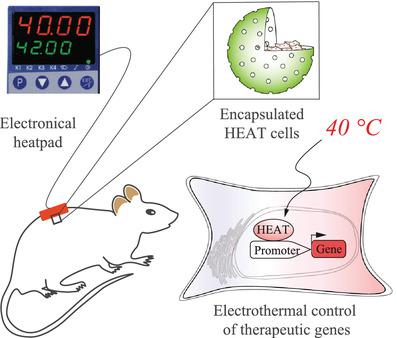Our official English website, www.x-mol.net, welcomes your feedback! (Note: you will need to create a separate account there.)
Genetically Encoded Protein Thermometer Enables Precise Electrothermal Control of Transgene Expression
Advanced Science ( IF 15.1 ) Pub Date : 2021-09-08 , DOI: 10.1002/advs.202101813 Bozhidar-Adrian Stefanov 1 , Ana P Teixeira 1 , Maysam Mansouri 1 , Adrian Bertschi 1 , Krzysztof Krawczyk 1 , Ghislaine Charpin-El Hamri 2 , Shuai Xue 1 , Martin Fussenegger 1, 3
Advanced Science ( IF 15.1 ) Pub Date : 2021-09-08 , DOI: 10.1002/advs.202101813 Bozhidar-Adrian Stefanov 1 , Ana P Teixeira 1 , Maysam Mansouri 1 , Adrian Bertschi 1 , Krzysztof Krawczyk 1 , Ghislaine Charpin-El Hamri 2 , Shuai Xue 1 , Martin Fussenegger 1, 3
Affiliation

|
Body temperature is maintained at around 37 °C in humans, but may rise to 40 °C or more during high-grade fever, which occurs in most adults who are seriously ill. However, endogenous temperature sensors, such as ion channels and heat-shock promoters, are fully activated only at noxious temperatures above this range, making them unsuitable for medical applications. Here, a genetically encoded protein thermometer (human enhanced gene activation thermometer; HEAT) is designed that can trigger transgene expression in the range of 37–40 °C by linking a mutant coiled-coil temperature-responsive protein sensor to a synthetic transcription factor. To validate the construct, a HEAT-transgenic monoclonal human cell line, FeverSense, is generated and it is confirmed that it works as a fever sensor that can temperature- and exposure-time-dependently trigger reporter gene expression in vitro and in vivo. For translational proof of concept, microencapsulated designer cells stably expressing a HEAT-controlled insulin production cassette in a mouse model of type-1 diabetes are subcutaneously implanted and topical heating patches are used to apply heat corresponding to a warm sensation in humans. Insulin release is induced, restoring normoglycemia. Thus, HEAT appears to be suitable for practical electrothermal control of cell-based therapy, and may also have potential for next-generation treatment of fever-associated medical conditions.
中文翻译:

基因编码蛋白质温度计可实现转基因表达的精确电热控制
人类的体温维持在 37°C 左右,但在大多数重病成人身上发生的高烧期间可能会升至 40°C 或更高。然而,离子通道和热激促进剂等内源性温度传感器仅在高于此范围的有害温度下才会完全激活,因此不适用于医疗应用。在这里,设计了一种基因编码的蛋白质温度计(人类增强的基因激活温度计;HEAT),它可以通过将突变的卷曲螺旋温度响应蛋白传感器与合成转录因子连接起来,在 37-40°C 范围内触发转基因表达。为了验证该构建体,HEAT 转基因单克隆人类细胞系 FeverSense,生成,并证实它是一种发热传感器,可以在体外和体内以温度和暴露时间依赖性触发报告基因表达。对于概念的转化证明,将在 1 型糖尿病小鼠模型中稳定表达 HEAT 控制的胰岛素生产盒的微封装设计细胞植入皮下,并使用局部加热贴片施加与人类温暖感觉相对应的热量。诱导胰岛素释放,恢复正常血糖。因此,HEAT 似乎适用于基于细胞的治疗的实际电热控制,并且还可能具有用于发热相关疾病的下一代治疗的潜力。将在 1 型糖尿病小鼠模型中稳定表达 HEAT 控制的胰岛素生产盒的微封装设计细胞植入皮下,并使用局部加热贴片施加与人体温暖感觉相对应的热量。诱导胰岛素释放,恢复正常血糖。因此,HEAT 似乎适用于基于细胞的治疗的实际电热控制,并且还可能具有用于发热相关疾病的下一代治疗的潜力。将在 1 型糖尿病小鼠模型中稳定表达 HEAT 控制的胰岛素生产盒的微封装设计细胞植入皮下,并使用局部加热贴片施加与人体温暖感觉相对应的热量。诱导胰岛素释放,恢复正常血糖。因此,HEAT 似乎适用于基于细胞的治疗的实际电热控制,并且还可能具有用于发热相关疾病的下一代治疗的潜力。
更新日期:2021-11-04
中文翻译:

基因编码蛋白质温度计可实现转基因表达的精确电热控制
人类的体温维持在 37°C 左右,但在大多数重病成人身上发生的高烧期间可能会升至 40°C 或更高。然而,离子通道和热激促进剂等内源性温度传感器仅在高于此范围的有害温度下才会完全激活,因此不适用于医疗应用。在这里,设计了一种基因编码的蛋白质温度计(人类增强的基因激活温度计;HEAT),它可以通过将突变的卷曲螺旋温度响应蛋白传感器与合成转录因子连接起来,在 37-40°C 范围内触发转基因表达。为了验证该构建体,HEAT 转基因单克隆人类细胞系 FeverSense,生成,并证实它是一种发热传感器,可以在体外和体内以温度和暴露时间依赖性触发报告基因表达。对于概念的转化证明,将在 1 型糖尿病小鼠模型中稳定表达 HEAT 控制的胰岛素生产盒的微封装设计细胞植入皮下,并使用局部加热贴片施加与人类温暖感觉相对应的热量。诱导胰岛素释放,恢复正常血糖。因此,HEAT 似乎适用于基于细胞的治疗的实际电热控制,并且还可能具有用于发热相关疾病的下一代治疗的潜力。将在 1 型糖尿病小鼠模型中稳定表达 HEAT 控制的胰岛素生产盒的微封装设计细胞植入皮下,并使用局部加热贴片施加与人体温暖感觉相对应的热量。诱导胰岛素释放,恢复正常血糖。因此,HEAT 似乎适用于基于细胞的治疗的实际电热控制,并且还可能具有用于发热相关疾病的下一代治疗的潜力。将在 1 型糖尿病小鼠模型中稳定表达 HEAT 控制的胰岛素生产盒的微封装设计细胞植入皮下,并使用局部加热贴片施加与人体温暖感觉相对应的热量。诱导胰岛素释放,恢复正常血糖。因此,HEAT 似乎适用于基于细胞的治疗的实际电热控制,并且还可能具有用于发热相关疾病的下一代治疗的潜力。



























 京公网安备 11010802027423号
京公网安备 11010802027423号